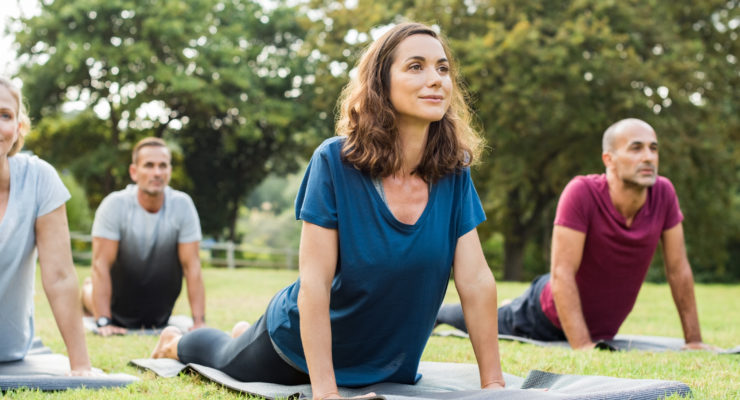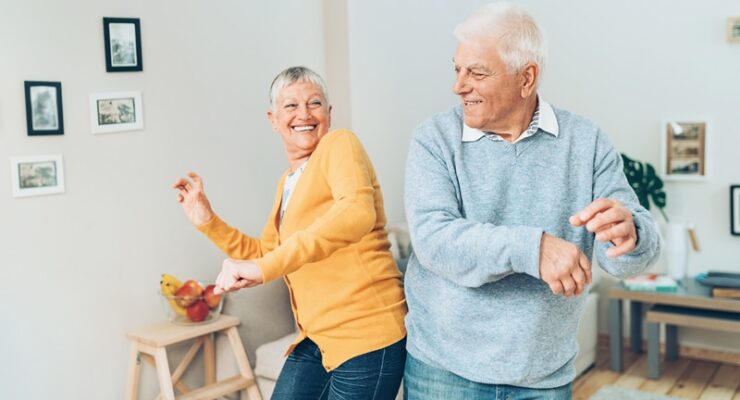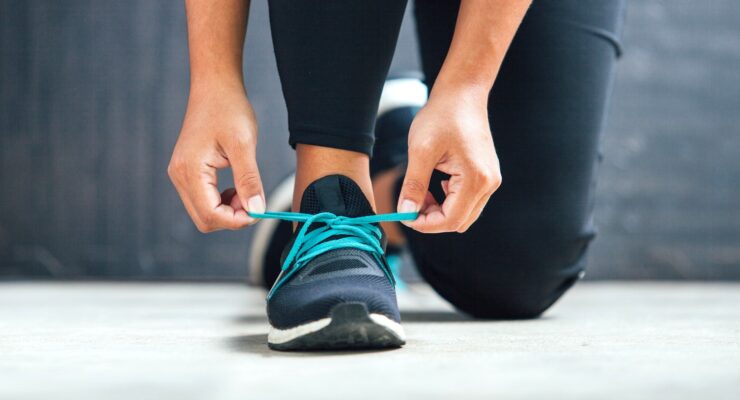Power Exercises: Arm Yourself Against Aging
Article posted in: Fitness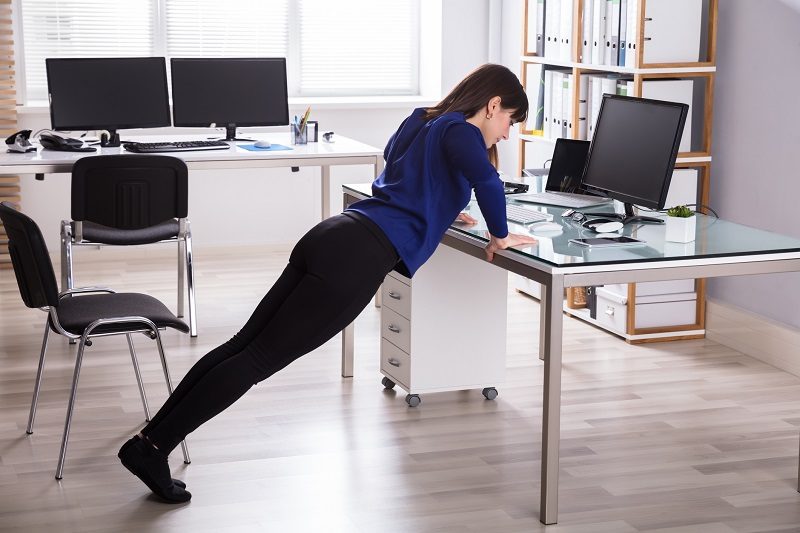
That’s power in the fitness sense: While strength is a measure of how much weight you can move, power is a measure of how fast you can harness your strength and get that weight moving. So if you can pick up a 50-pound sack of potatoes, even if it takes a whole minute, you have the strength to lift it. But if you can muster all that 50-pound strength fast, that’s thanks to power. Even if it still takes a minute to lift it, if you’re quickly generating your maximum level of force, and engaging in a form of power exercises.
As you age, that power is diminishing fast: Muscle mass diminishes by as much as one percent per year starting in your 40s and 50s, which according to the Journal of Physiological Anthropology, is known as a process called sarcopenia. And research published by Wien Med Wochenschr shows that much of that loss is from fast-twitch muscle fibers, the type used in moments of fast or heavy exertion—power exercises.
And those power exercises aren’t just about picking something up quickly: When you slip, your ability to recover quickly before falling down—that’s thanks to power exercises. Having the power to recover and not fall could greatly affect your quality of life. According to the Centers for Disease Control and Prevention (CDC), one out of four Americans age 65 and older fall each year. Those victims account for 2.8 million trips to the emergency room, 800,000 hospital admissions, more than 95 percent of hip fractures and more traumatic brain injuries than are caused by any other kind of accident.
The good news: You don’t have to sling huge barbells over your head to develop and maintain muscular power. You just have to perform strength exercises with power—that is, moving the weight or your body with controlled, fast force.
Check out these five power exercises that require little to no equipment, very little skill to learn, and can help you build power to fight aging:
Exercise 1: Chair Squat


A study found in the European Journal of Preventative Cardiology found that the ability to get off the floor without using your hands was a key indicator of whether participants were more likely to die prematurely. With this exercise, you’ll develop that ability while building strength in your legs and working on your balance—and if you stumble, you’ll land safely back in the chair.
How to do it: Stand in front of a stable chair with your feet about hip-width apart. Imagine that you’re holding a bag of groceries, and there’s a door ajar behind your butt. Bump your butt backwards as if to open that door—this initiates a hip hinge, keeping your weight in your heels and your back flat. Keep pushing your hips back to sit down in a controlled manner without using your hands. Now, sitting up straight in the chair and keeping your weight in your heels, forcefully stand back up.
To make sure it’s a powerful move, try to stand up quickly. Even if you can’t, try to muster all your strength in the first moment of the standing movement, so you’re using your strength from the start. And to keep it powerful, don’t do all of your repetitions quickly. Once you sit back down, compose yourself, reset and push up forcefully again. Repeat this for five sets of five repetitions each day, resting a full minute between sets.
Exercise 2: Glute Bridge
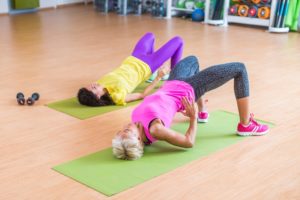

The glutes are one of the biggest muscles in the body, but because we sit so much, many people suffer from what has been called “gluteal amnesia,” where the butt doesn’t do the work it’s supposed to. Being able to fire the glutes can help keep your lower back in place, reducing your risk of pain. And despite the booty focus of many female workouts, women actually have, on average, less gluteal and hip muscle mass than men, according to International Orthapedics. A simple glute bridge, though, can help you “remember” how to use your glutes, develop more muscle and because it’s safe to do forcefully on the ground, make that butt muscle powerful.
How to do it: Lie face-up on a mat with your knees bent and feet flat on the floor. Place your arms at your sides, palms up. Keeping your feet flat on the floor, squeeze your glutes to raise your hips forcefully off the floor until your body forms a straight line from your knees to your shoulders. As you’re lifting, keep your knees and thighs parallel—don’t let them pull together. This will engage your hip musculature. Pause for a second at the top of the exercise, and then slowly return to the start position. As you’re raising up, don’t let your heels come off the floor.
To make sure it’s powerful, take a beat between repetitions, just as with the chair squat. Concentrate on pushing the hips up rapidly, and control the descent down. Perform three sets of five to eight repetitions of this exercise each day.
Exercise 3: Elevated Pushup
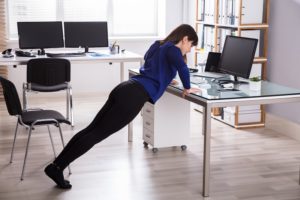

If you can’t do a bunch of pushups without struggling, elevating your hands can help make the movement easier and allow you to perform the exercise while recruiting force in a powerful manner. It can also help you keep your form in check, which can reduce your risk of shoulder injury and give the benefits you’re really looking for.
How to do it: Place your hands shoulder-width on the arm of a sofa or the second step of a staircase. In this position, assume a straight body line from head to heels. Bend your elbows to lower your body until your chest reaches your hands, maintaining the rigid body line throughout the movement. Press forcefully back to start, maintaining the body line. Try for five reps to start, working up to five sets of five reps. Once that’s too easy, try the exercise with your hands lower—maybe on the first step of the staircase.
Exercise 4: Medicine Ball Chest Pass
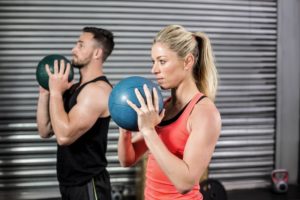

The next two exercises require some equipment, but if you can get a medicine ball, it’s really fun: Throwing the medicine ball won’t just build power, but will make you feel powerful. It can be great for stress relief, too! If you can, try to find a soft-sided medicine ball that doesn’t bounce—instead, it will hit the wall and fall to the ground. This is easier to handle than trying to dodge or catch the ball as it returns to you. As with the other exercises, don’t let this medicine ball work become cardio—it falls under the power exercises category, so each repetition should be powerful! Take a second between reps to compose yourself, get reset, and throw the ball with power.
How to do it: Stand with knees slightly bent facing a wall three to four feet away, holding a medicine ball at the chest with both hands. Press both arms forcefully forward to push the ball away from you at the wall. Retrieve the ball, reset, and repeat. This exercise can also be done while seated. Perform five to eight throws.
Exercise 5: Medicine Ball Slam


As with the chest pass, take a moment to rest between power exercises so you’re composed and ready to throw the ball with maximum power!
How to do it: Stand in the same position as you did for the chest pass, holding the ball in front of your chest. Raise your arms up over your head, and then forcefully slam the ball down in front of your feet. Retrieve the ball, reset, and slam it again. Perform one set of eight reps.
On the Nutrisystem program, we recommend 30 minutes of exercise each day. Try incorporating some of these moves into your daily routine and arm yourself against aging!
Looking for more workout inspiration? Check out Tone Up While Sitting Down with 6 Easy Chair Exercises >

